Ever wondered what the difference is between CPOP, HPOP, and CPHP? I’m hoping to set the record straight when it comes to various methods of using heat to aid in the soapmaking process. Or, at the very least, I’ve set out to tell my own accounts of what happens when I soap with these different methods. I’ve already rocked out some CPOP and CPHP tutorials, and today we’ll be visiting HPOP.
HPOP: Hot Process Oven Process. This method of using hot process calls for heat being applied while the soap spends time in the oven. Like the oven’s purpose in CPOP, and the crock pot’s purpose in CPHP, the oven facilitates holding the temperature of the soap at or above 160 degrees, speeding up the saponification process. Remember from the CPOP post that according to Professor Kevin M. Dunn, author of Caveman Chemistry and Scientific Soapmaking, heat speeds along the saponification process. The major difference is that HPOP cooks the soap in oven before it goes into the mold instead of after, which gives the finished soap a more rustic look. Questions? Check out the FAQs at the end of the post!
Click here to tweet this tutorial!

Recipe:
0.2 oz. Castor Oil
4.6 oz. Coconut Oil
2.3 oz. Hempseed Oil
5.8 oz. Olive Oil
4.6 oz. Palm Oil
5.5 oz. Rice Bran Oil
3.14 oz. Sodium Hydroxide (Lye)
7.6 oz. Distilled Water
1.5 tsp. Sodium Lactate
0.4 oz. Gardenia Fragrance Oil
0.4 oz. Lemongrass Essential Oil
0.4 oz. Patchouli Essential Oil
2 teaspoons Purple Brazilian Clay
2 teaspoons Yellow Brazilian Clay
2 teaspoons Dark Red Brazilian Clay
2 pound Wood Loaf Mold with Wingnuts
Oven-safe Container (I used the stainless steel vessel from a Crock Pot)
Click here to add everything you need for this recipe to your Bramble Berry shopping cart!
OVEN PREP: Adjust the racks in the oven so that there is one rack on the lowest notch, and one rack just above it. Be sure that the central rack isn’t too close to any heating elements. Line the bottom of the oven with foil, or place an old cookie sheet on the bottom rack (in case of soap overflow). Preheat the oven to 170 degrees Fahrenheit.
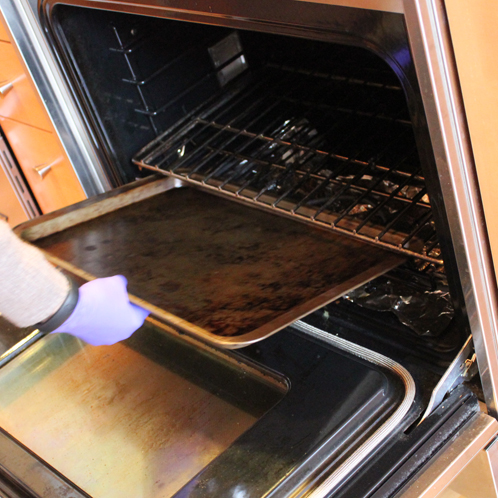
COLOR PREP: Disperse the clays in water. The Yellow and Dark Red Clays get 1.5 Tablespoons of water, and the Purple gets 1 Tablespoon of water. Use a mini mixer to make quick work of the dispersing, but be sure to saturate the clays in the water with the tip of the mixer before turning it on (or you’ll wind up with a bit of a mess!). The reason we disperse the clays in water is to make them easier to mix in. Also, clays absorb water so they can make your soap crack (if they absorb the water in your soap).
MOLD PREP: Line the Wood Mold with freezer paper shiny side up. In this tutorial, I used an early-release exclusive-to-Bramble Berry silicone liner for the 2 pound molds.
SAFETY FIRST: Suit up for safe handling practices! Goggles, gloves, and long sleeves are your soap making uniform. Be sure that kids and pets are out of the house or unable to access your soaping space, and always soap in a well-ventilated area. Make sure the soap volume will not fill up more than half of your crock pot. If you have never made cold process soap before, I highly recommend you get a couple of basic recipes under your belt before trying out this tutorial. Check out this (free!) 4-part series on cold process soap making, especially the episode on lye safety. Bramble Berry carries quite a few books on the topic as well, including this downloadable e-book on making cold process soap.
ONE: Carefully add the lye to the water and stir until clear. Set aside to cool.
TWO: Melt and combine the Coconut and Palm Oils in your oven-safe container or the microwave. Add the Castor, Hempseed, Olive, and Rice Bran Oils and stir well.
THREE: Once the lye water and oils have cooled to 130 degrees Fahrenheit, slowly and carefully add the lye water to the oils. You can pour down the shaft of your stick blender or spatula to prevent bubbles. Stick blend the mixture until light trace is achieved. Do not fill your pot over half full. Every so often, the soap can foam up during this process and make a mess in your stove. More headspace will help to prevent this.
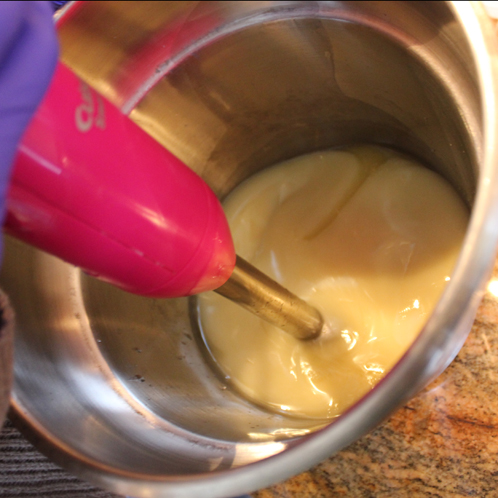
FOUR: Place the soap in your pre-heated oven and set the timer for 15 minutes. I took the opportunity to write some Christmas cards!
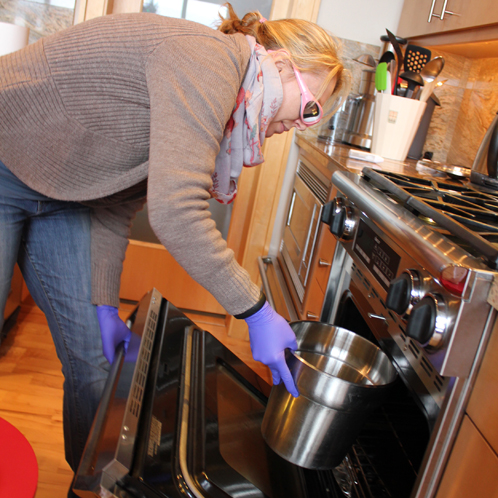
FIVE: Check the status after 15 minutes. Has the soap started to gel yet? You can tell that the soap is starting to gel when you see a darker-hued and gelatinous-looking ring starting to form. Nothing yet? Stick that batch back in the oven for another 15 minutes. My soap wasn’t even hinting at gel phase after the first 15 minutes.
SIX: Repeat step five until your soap has gone through a full gel phase, meaning the entire soap has taken on the darker-hued and gelatinous look. My soap reached partial gel phase (darker-hued and gelatinous-looking ring around the outside) after 45 minutes, and full gel phase after 60 minutes.

SEVEN: Once your soap has fully gelled, remove the soap from the oven (note: I am wearing hot pad gloves; you should too) and add 1.5 teaspoons Sodium Lactate. Stir up the soap; it should have the consistency of mashed potatoes when it mixes, not too wet and not too dry. Add the Patchouli Essential Oil, Lemongrass Essential Oil, and Gardenia Fragrance Oil and mix well.
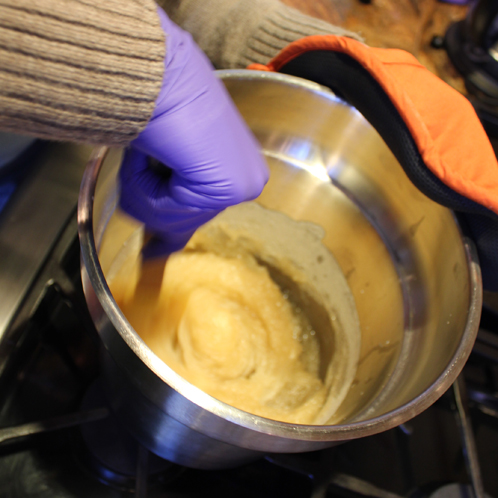
NOTE: For the next steps, be prepared to move quickly! The soap may start to harden/dry up, and you want to be able to get all of your colors mixed in and the soap in the mold before that happens.
EIGHT: Split the soap into three equal parts. You can just eyeball each portion. Color each of the parts as follows: 3.5 teaspoons dispersed Yellow Clay, 1.5 Tablespoons dispersed Dark Red Clay, and all of the dispersed Purple Clay. Mix in well.
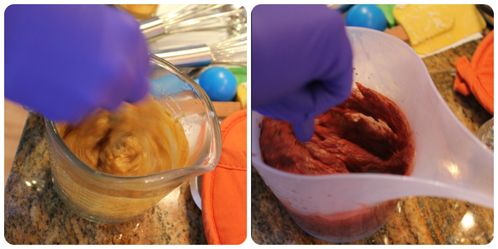
NINE: Pour (or plop) the soap into the mold, starting with the Yellow colored soap. Once all of the Yellow soap is in the mold, spread it out using a spatula to create a perfectly imperfect layer, then tamp the mold on the table to eliminate air bubbles. Follow the Yellow soap with the Dark Red soap, plopping the soap on top of the Yellow layer then spreading it out with a spatula. Tamp the mold to remove air bubbles, then pour the final Purple layer.

TEN: Use a spatula on the final layer to create soapy peaks. Allow the soap to sit in the mold for 24 – 48 hours. Unmold, cut, and this soap is ready to use right away (but it will last longer in the shower if you allow it the standard 4-6 week drying time).
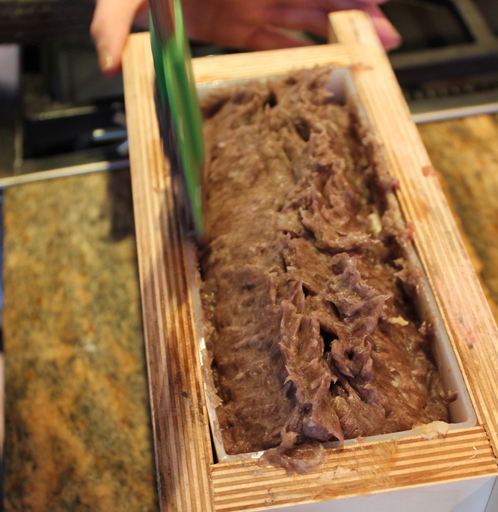
FAQ section
Q: Why sodium lactate?
A: I find that it helps to keep the soap workable, longer. It’s optional.
Q: How is this different than traditional hot process?
A: The concept is the same but the method of heat delivery is different. You don’t need to buy a crockpot (yay!). The soap turns out remarkably similar looking.
Q: I simply hate that rustic look. How can I make this smoother?
A: You can make it smoother by adding more liquids at the end – liquid oils, water, teas etc… Keep in mind that more liquid = longer curing and drying time.
Q: What molds can I use?
A: Any mold that can sustain temps of 170 degrees. All of the Heavy Duty Molds, Milky Way Molds, Silicone molds and most wooden molds can easily sustain these temperatures.
Q: What fragrance oils and essential oils can I use?
A: Anything that is safe for skin – no potpourri or candle fragrances. Some more delicate essential oils, like orange essential oil, for example, may not make it with the extra heat
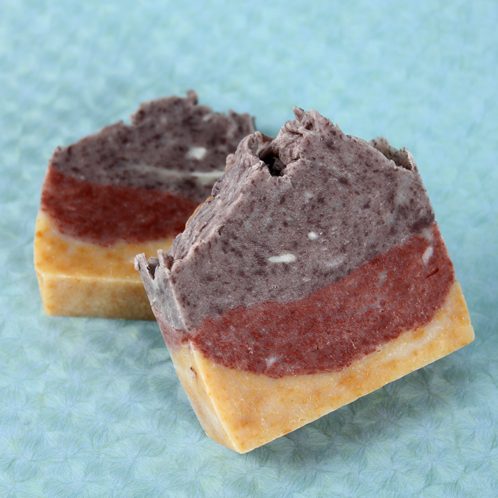
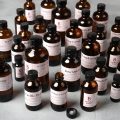
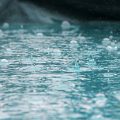
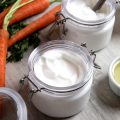
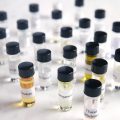
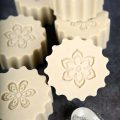
I’m wondering if there any method like that: pour soap into the mold (for example slab from BB) and then put into the oven, so the soap will cook and all I will need just to unmold ready to use soap after a certain time. I guess it may be possible with unscented soap, but have doubts. Please, advice. Thank you!
Hi Veronika!
The Cold Process Oven Process Method is ready to use after 24 hours!
The reason we recommend letting it cure for four weeks is so water in the soap will evaporate off and you’ll have a harder bar of soap.
Hot Process Series: CPOP Swirls: http://www.soapqueen.com/bath-and-body-tutorials/cold-process-soap/hot-process-series-cpop-swirls/
-Kelsey with Bramble Berry
I’ve been researching soapmaking… just so you know I’m a total newbie. How does the HPOP affect fragrance? Is it pretty much like regular HP soap – a stronger fragrance than CP and less warping of the scent?
Hi Rebecca!
I have not noticed a large difference between HP and HPOP and how it effects the fragrance. All methods of soap making (CP, HP, etc) will slightly effect the strength of the fragrance, but it varies widely depending on what fragrance is being used, how much is used, and other factors relating to methods
-Amanda with Bramble Berry
Georgia (I hope you get this comment);
Do you not use a stickblender when soaping? I do straight hp and use a stickblender all the time. As I am loading my soap molds and at regular intervals, I give the mold a couple of good raps on the counter/floor. And I mold HOT. That combo removes most bubbles but I will have a small one here or there on occasion.
Hi Kerry!
Thanks so much for your feedback. It is always great to hear from our customers and the techniques that they use to make their soap. If you get any fun pictures of your batches, be sure to share them on Bramble Berry’s Facebook page. =)
Happy Soaping!
-Becky with Bramble Berry
https://www.facebook.com/BrambleBerry
Thank you Becky. You’ve expanded my knowledge base….am a neophyte soap maker! But my question wasn’t answered – whether there are tiny air bubbles in the soap that are also being removed. It would seem that air is introduced when using the hand held immersion blender.
Hi Georgia!
Sorry for missing your question. There are air bubbles in your soap, but the baking of the soap isn’t actually going to get rid of them. All ‘baking’ your soap is going to do is remove the excess moisture and give you a shorter cure time.
The best way to make sure there isn’t too many in your end product is to “burp” your stick blender before you blending your oils/butters, water and lye. For more on ‘burping’ your blending, you can check out this post:
Avoid Pesky Air Bubbles in CP: http://www.soapqueen.com/bath-and-body-tutorials/cold-process-soap/avoid-pesky-air-bubbles-in-cp/
I hope this helps to explain it a bit better!
-Becky with Bramble Berry
Are there bubbles being ‘cooked’ out of the soap during the warm oven phase?
filled molds baking for 2 hrs. at 200 degrees F. and then sitting in the oven to cool over night
Hi Georgia!
During the oven phase, the extra moisture is actually being cooked out of the soap so that you can produce a harder bar in a shorter amount of time. With CPOP, you can typically used your soap within a week of finishing it. Normal cold process takes 4-6 weeks to cure. I hope this helps to explain it!
-Becky with Bramble Berry
You achieved such beautiful dark colors with the clay… absolutely gorgeous!! Can you tell me if your soap colored the lather after use? I typically use 1 tbsp of the Brazilian clays at trace (1 lb batch of soap) and unfortunately I always get colored lather when I test it after 4 weeks. Maybe I used too much clay? I don’t disperse it in water first – do you think that could be the issue?
Hi Kim!
When we used the Brazilian Clay in our cold process soaps, we did disperse it water beforehand because the clays are extremely absorbent and we have found this is the best way to get an even color without our soap separating or accelerating trace.
The particular recipe you are looking at above is actually a 5 lb recipe and we used 2 teaspoons of each of the three clays in the entire batch.
In your next batch, I would definitely suggest pre-dispersing your clay in water beforehand and see how that helps your soap out.
Happy Soaping!
-Becky with Bramble Berry
Simply GORGEOUS, Anne-Marie! I’ve never tried layering HP, but you have inspired me to give it a go -Thanks so much!
You will just love HPOP (Hot Process Oven Process), Becky! It is such a fun method of soapmaking and we can’t wait to see how yours turns out.
-Becky with Bramble Berry
This is the method I’ve used from the beginning of my soap making venture and the one I posted on my page. This give me even more comfort knowing the Soap Queen uses my method. Thank you Anne Marie.
I’m so glad that you’ve figured a method that works so well for you. We’d love to see some of your soapy pictures. You can share them with us on Bramble Berry’s Facebook page:
https://www.facebook.com/BrambleBerry
Happy Soaping!
-Becky with Bramble Berry
Hi Becky,
I plan to post some this weekend. I have started CP’ing because of the many different methods there are to making the soap stand out. But I will say this, I get rave reviews for the CPOP I do. My method of CPOP.
Thank you all for being here (there) for all us newbies or oldies.
Love the rustic textures, very distinctive. Thanks for sharing!
Thanks for showing HP soap some love!!!. I love the clays and the organic feel to that soap. Also- thanks for not doing it in a crock pot. LOL I know many people use them but I have never turned out nice soap with them and HP is almost all I do. The oven is most definitely the way to go.
We’d love to see some of your soap, Danni! We are always love looking at our customers newest and greatest creations. You can share them with us on Bramble Berry’s Facebook page.
https://www.facebook.com/BrambleBerry
-Becky with Bramble Berry
I agree this is the best HP method and the only one I’ve used. I’m just now started trying out CP. I made a lovely CP with the intentions of CPOP but after leaving this in the oven for a mere 25min on 170 all the oils floated to the top and ruined the batch. Made me very sad so from now on its HP or CP no more mixed methods. I am with you HP doesn’t get the high fives it should.
I wonder about the trace that you were at? Was it a very thin trace? Is it possible that it started separating?
Anne-Marie,
I think I got a false trace, since I soap at room temp. That day it was a bit cool in the house so I think my trace was really just a good mix, I haven’t tried it again because I am afraid I will ruin another batch of soap.
I have CPOP from the start of my soap making career, I have found if I will take 1 or 2 smaller stainless pots, put them in the oven to heat so when I divide up my soap for colorant or herbs etc I put what I need in the hot pot. Then,. I put the pot back in the oven that I’m not using and it stays warm and workable vice putting it in a pot and leaving it on the counter while I pour the other portions. Also, for me I can start mixing and coloring when I have full gell I never let it get to the mash potato stage. Of course I let it cure for 3 weeks to insure all the oil/lyes are full incorporated.
Thank you for sharing your knowledge, I have learned so much from you and other teachers on the web. I just placed my 2nd order from Brambleberry and I can not wait to get the good smellies.
I hope to make this my 2nd career, it’s time to leave the federal government for something fun to do.
When I make hp soap and I use milk of either goat or coconut the oils always seperate, if you just take a wisk and give the oil and solids a good beating it will all come back together again….
I saw that too Margo! I am looking for a great silicone liner for a 2lb mold as well. I hope BB starts carrying one. I have always been happy with the products I get from BB.
Hi Melissa!
We are actually going to be carrying the silicone liners for the 2 lb. molds quite soon. If you are interested in getting one and want to keep up-to-date on when we release it, you can send an interest e-mail to sma(at)brambleberry(dot)com and we will e-mail you when they are in!
-Becky with Bramble Berry
I’m looking for one too
Hi Marilyn!
We’ve actually just released our 2 lb. silicone mold liners, you can find them here:
Silicone Liner for 2 lb Wood Mold: https://www.brambleberry.com/Silicone-Liner-for-2-lb-Wood-Mold-P5540.aspx
-Becky with Bramble Berry
Thank you for posting this, I am going to have to give it a try. Is that a silicone liner I am seeing in this smaller loaf mold? I have your 5 lb. silicone liner and was hoping for a smaller one also.
Hi Margo!
That is a silicone liner that you see for the smaller 2 lb. loaf. We plan to be selling them soon and if you want to know when we receive the full stock, you can send an e-mail to sma(at)brambleberry(dot)com and we will will keep you updated about their release time.
-Becky with Bramble Berry
COOL It’s so neat that you can make rustic-y soap w/o rebatching! I’ll stick w/ basic CP for now though….until I have more experience
It’s so neat that you can make rustic-y soap w/o rebatching! I’ll stick w/ basic CP for now though….until I have more experience 
~Nickie~
Would this also work with the rebatch?
Hi Tracy!
What a great question! You can use this technique (oven) for both cold process and rebatch soaps and it would work just fine. If you are referring to the layers, we actually recently made an Ombre Layers Rebatch soap that is just so darn cute.
Ombre Rebatch Layers: http://www.soapqueen.com/bath-and-body-tutorials/cold-process-soap/ombre-rebatch-layers/
I hope this helps! =)
-Becky with Bramble Berry